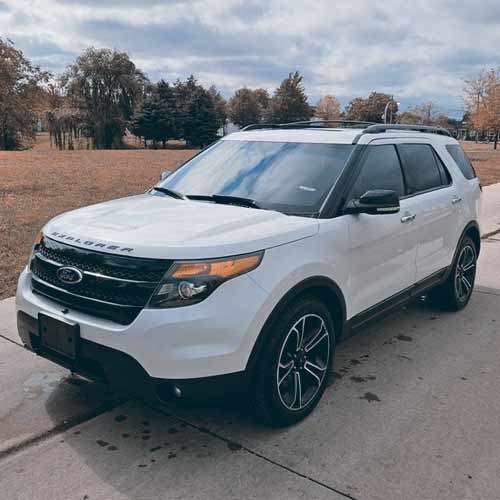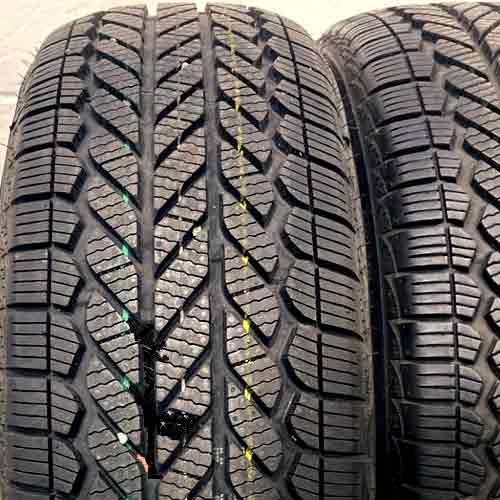The Bridgestone WeatherPeak positions itself as a versatile all-weather grand touring option, bringing a balanced blend of performance across various environments and terrains. Let’s see if this tire’s made for you.

As a tire engineer, my tests show that the all-weather Bridgestone WeatherPeak provides notable wet performance, exhibiting exceptional grip, handling, and hydroplaning resistance, thanks to its unique design featuring full-depth sipes and aqua channels. Though the tire needs to improve its dry performance (braking, in particular). But yes, you get good enough impact comfort performance out of these boys. Plus their lighter design deliver above average fuel economy and tread longevity.
Table of Contents
Info on Sizes
The Bridgestone WeatherPeak comes with 15 to 20 inches wheels, and those have following specs.
- Speed ratings: T, H and V.
- Load ratings: SL and XL.
- UTQG: 700 A A.
- Tread depth: 10/32″.
- Weight range: 17 to 30 lbs.
- Winter ratings: Yes both M+S and 3PMSF available.
- Tread warranty: 70k miles.
Tread Appearance
The Bridgestone WeatherPeak gives you an innovative (and symmetrical) tread pattern, where it features sharply squared off lugs, deliberately positioned to furnish superior traction and control.

These lugs group to form three central ribs, which, in turn, making four robust, circumferential grooves, creating excellent aqua channels.
The central most rib, has lugs with slightly more width to them, and they are also a little packed up, compared to surrounding ones.
This compact central region ensures decent braking and acceleration capabilities.
Embedded within these lugs are zigzag sipes and chamfered edges, and these features basically boost stability and grip across a variety of conditions, including snow and ice.
Speaking of its shoulders, the blocks there are noticeably larger, and these are characterized by smoother edges and linear sipes.
And yes, you can also see thick longitudinal slits there too, these add to the tire’s overall stability and traction.
Compare Bridgestone WeatherPeak With Others
- Firestone WeatherGrip
- Bridgestone Ecopia
- Michelin CrossClimate 2
- Firestone Destination LE3
- Nokian WRG4
- Bridgestone Turanza QuietTrack
- Pirelli Scorpion WeatherActive
- Goodyear Assurance WeatherReady
- BF Goodrich Advantage Control
Dry Performance
The dry performance of a tire largely hinges on its grip and handling abilities, where the grip (also called directional grip), is typically determined by braking distances, while handling encompasses cornering and lateral traction (measured with G forces).
Let’s talk both in details.
Dry Traction
The Bridgestone WeatherPeak, with its high silica compound, delivers a soft yet resilient material that sticks pretty well to road surfaces.
But compared to other premium all-season tires, the tire still lacks a bit.
Basically it does not offer effective rubber-to-road contact due to its broader grooves. And these tread voids (needless to say), reduce the amount of rubber that could be in direct contact with the road, leading to a decrease in grip.
Side Note: The tire’s tread is basically optimized for a longer tread life, and that’s also one of the reason, why its not able to perform so great grip wise.
Wet Performance
Wet performance is where the Bridgestone WeatherPeak shines, as it offers great water clearing properties.
Basically 2 crucial elements determine the wet performance of a tire, where one is the overall traction (grip and handling), and the other is the hydroplaning resistance. Let’s examine both.
Wet Traction
In wet conditions, the WeatherPeak benefits significantly from its numerous, and full-depth sipes with a wave-like (interlocking) pattern.
This zigzag design allows the sipes to remain flexible and avoid stiffening up (which mostly happens during cornering, or handling).
Basically such sipes possess an interlocking pattern, enabling them to expand and contract depending on the surface and g-forces they encounter.
Furthermore, as all sipes are full depth, they are able to create substantial vacuum upon contact with the surface, effectively draining water from beneath.
Side Note: If wet traction is your priority, you may want to check out my list of top grand touring tires: https://tiredriver.com/best-grand-touring-all-season-tires/ FYI, the WeatherPeak couldn’t make it to my list.
Hydroplaning Resistance
Most of the water is channeled out of the tire through the help of grooves, (while remaining is dealt with sipes), and these grooves/voids determine the overall resistance to hydro or aquaplaning.
Now the Bridgestone WeatherPeak with its four evenly spaced aqua channels offer sufficient water clearing to maintain decent float speeds.
And yes, these channels, interlinked with lateral groove notches, facilitate water flow towards the sides and out of the tire.
Moreover, with softer and elastic tread compound, the tire creates great negative pressure, pushing water out quickly.
Fuel Efficiency
Fuel efficiency is influenced by tread composition, weight, and a tire’s rolling resistance.
That’s why it can be explained why the Bridgestone WeatherPeak excels here, providing adequate fuel economy (compared to other all season tires out there).
Although it may compromise slightly on grip, it trades it off with smaller rolling resistance, primarily due to its lighter weight.
Its light weight construction basically reduces the pressure exerted on the lugs, resulting in less friction against the ground as the tire rolls.
A Side Note Here: If fuel economy is something you’re looking for, you should know that standard touring tires are much better at it. I mean grand touring like Bridgestone over here can’t outperform them here. It’s not complicated anymore, once you check out my main all-season tire page.
Winter Performance
The Bridgestone WeatherPeak’s winter traction is above average, on both soft snowy tracks, as well as ice. That’s why it makes sense why it is branded with both the 3-peak mountain snowflake rating and the M+S.
So this tire basically has ample tread voids, which pick up snow, providing snow to snow contact, and enhancing friction on softer terrains.
(If you are wondering why is that, know that snow sticks better to snow, instead of rubber).
Moreover, the tire’s numerous siping (like mostly seen on winter tires), create decent grip on packed up snow/icy tracks as well.
And with it’s softer rubber compound, it doesn’t harden in freezing temperatures, staying flexible and providing essential tread adaptability for wintry conditions.
Other Performance Factors
Additional on-road factors impacting the Bridgestone WeatherPeak relate to steering response and stability.
Steering Response
While WeatherPeak isn’t overly responsive, it still offers satisfactory performance.
I mean its steering input experiences a slight delay, leading to a slightly unbalanced under-steer.
This is because the tire’s soft compound gives the feeling of the car resting on them, slowing down the steering response and making the tire slightly more difficult to steer compared to other premium all-season tires in its price range.
Side Note: The tire provides better feedback on wet roads than on dry ones.
Cornering Stability
The same factors affecting steering response also impact the Bridgestone WeatherPeak’s lateral traction, which, although above average, isn’t exceptional.
So why is that?
Well, first, you should know that as the tire corners, the weight shifts towards edges of tread (shoulders). So a good tire should be able to make a decent contact patch from its shoulders, and it should also offer a harder compound which would not bend (causing over or under steering).
Now in case of Weatherpeak, its spongy tread is the main culprit limiting cornering stability.
Although the tire uses connectors between shoulder blocks to keep the soft blocks stable, it could still use a little stiffness there.
Road Noise
Noise is primarily caused by air particles striking the tread. But where do that air come from, well, it enters mostly through the shoulder voids.
Despite its premium price, the Bridgestone Weatherpeak doesn’t deliver impressive noise reduction. However, its still not that bad, as it incorporates unique features that help mitigate this issue.
The tire basically uses connectors between the shoulder blocks, not only stabilizing the tire’s handling but also reducing noise levels by limiting air entry.
And yes, it also uses variable pitch technology, where ribs of different variants create multiple pitches that neutralize each other to dampen noise.
Ride Comfort
Ride comfort isn’t solely dependent on road noise; the tire’s ability to absorb bumps also plays a significant role.
Having said that, the Bridgestone WeatherPeak, while lacking in noise reduction, delivers excellent ride comfort, as it offers a smooth driving experience, even on uneven asphalt, as its (comparatively) softer tread effectively dampens bumps.
Tread Wear
On average, all season tires offer an average tread life of 50 to 60k miles, but in case of the Bridgestone WeatherPeak, you get 70k miles warranty.
Even though its tread compound is softer (compared to others), its still elastic, which means, it would wear down to the 2/32″ replacement tread depth slower.
(It uses a unique tread composition containing resins, silica, and other polymers, and this composition enhances the tire’s flexibility and resistance to tread cuts and chips).
The tire is also pretty light in weight, so there’s smaller pressure on its lugs. So they burn against the ground with a smaller force, and yes, speaking of which, it uses technology that ensures uniform tire wear due to evenly distributed pressure points across the tread.
All these features make this tire great when it comes to tread life.
Side Note: The tire offers the UTQG of 700 (a pretty good treadwear rating).
Off Road Performance
Though all-season tires generally don’t fare well on off-road terrains, the Bridgestone WeatherPeak shows decent capability in this area, I mean comparing how other tires in the category performed here.
It basically offers sufficient tread to voids ratio, allowing for quicker mud, and dirt removal.
Key Takeaways
So overall, the Bridgestone WeatherPeak is a solid choice for an all-season tire, but it leans more towards enhanced wet road performance than dry.
And yes, although its grip is limited, its a trade off with its lower rolling resistance which aids fuel economy and tread wear longevity.
Moreover, the tire also offers superb comfort levels, though it still needs to work a little on its noise production.
WeatherPeaks 225/60-18 on 2019 Outback Touring are NOISY – they were decently quiet for about 3500 miles , then got REALLY NOISY – had them rotated at 4500 miles but it made no difference in noise; per the review , the good news is that they reduced the twitchy quick bite of the oem Duelers that tended to promote oversteer; they replaced the oem Duelers which lasted about 38,000 miles & were very quiet thru entire life; purchased from COSTCO April 2024 on basis of above Tiredriver Review;